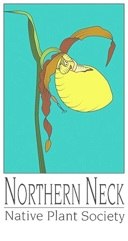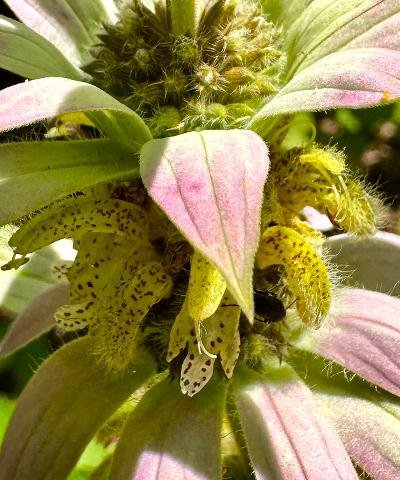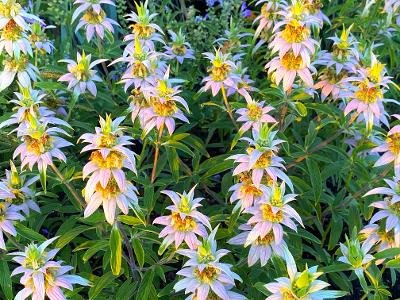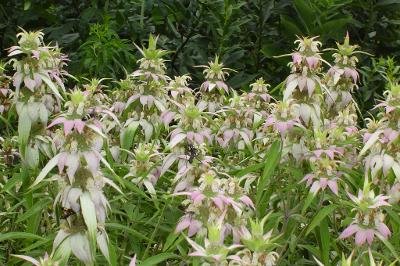Plant of the Month August 2023: Spotted Beebalm
Detail of intricate beauty of Spotted Beebalm flowers and Spotted Beebalm massed at the front of a border (by B. Washington)
Spotted Beebalm, Monarda punctata
August 2023 Plant of the Month
Northern Neck Chapter of the Virginia Native Plant Society by Betsy Washington
Spotted Beebalm or Eastern Horsemint is an eye-catcher with plenty of charm when it blooms from late July to September and is easy to fall in love with. The flowers are not quite as large and impressive as some other Beebalms but they make up for it with intricately beautiful and showy flowers. Spotted Beebalm is a member of the mint family and like other mint family members, has 4-angled stems, opposite toothed leaves, and is quite aromatic. This compact perennial has erect stems that often branch near the top and typically reach between 2 - 3’ high and wide. The real show begins in late July and can last into September when the architectural inflorescences add texture and drama to any landscape. The flowers are arranged in a series of two to six whorls near the top of the stem and in leaf axils and each whorl is surrounded by showy, leaf-like bracts that look more like petals than leaves. The green-tipped to whitish and purple-pink-tinged bracts encircle the base of each whorl of flowers and remain showy long after the flowers have been pollinated. The actual flowers are pale yellow and are heavily spotted with purple. Each is about 1” long and arches strongly outward, bearing two lips – a stiff strongly arching upper lip and a broader, 3-lobed lower lip and are strongly bearded with fine hairs. The whole effect is enchanting!
Spotted Beebalm is a perennial native to the eastern the United States and ranges from Canada south to Florida and Texas in prairies, rocky woodlands, and sandy coastal areas. In Virginia, it is frequent in the Coastal Plain where it is often found in dry, even poor, sandy soils in old fields, grasslands, sand hills, maritime forests, and woodland dunes. Infrequent in the Piedmont and rare in the mountains, I count myself lucky to live in the coastal plain where Spotted Beebalm occurs frequently.
Rich in pollen and nectar, Spotted Beebalm is an excellent pollinator plant. It attracts a variety of beneficial insects including bees, butterflies, moths, and hummingbirds. Spotted Beebalm also supports at least three specialist bee species that depend on this beebalm to supply pollen for their young, as well as being a host for two species of moths. The showy flowers are followed by four, smooth brown nutlets that are relished by songbirds.
Spotted Beebalm is easy to grow and quite drought tolerant. It prefers sandy soils in full sun but will tolerate part shade and poor dry soils where many other plants fail to thrive. Like many mint family members, it spreads by runners and will form a large clump 2 – 3’ wide but is not considered an aggressive spreader like some other mints. Powdery mildew can occasionally be a problem if crowded, but this is easily remedied by thinning out some stems to increase air circulation. Removing spent flowers may prolong the blooms, but birds relish the seeds so be sure to leave some for them. Spotted Beebalm also has the bonus of making a splendid, long-lasting cut flower. What a buffet in one tough wildflower!
This charming wildflower is a perfect choice for butterfly and pollinator gardens, cottage gardens, or meadows. Try it at the front of a border or along a path where the intricate flowers and aromatic foliage can be enjoyed up close and personal. Or take advantage of its tough nature and plant it in masses in a tough, dry spot with poor soil. Although sometimes short-lived, Spotted Beebalm reseeds readily and usually persists in the garden. The foliage and flowers are strongly aromatic and contain the essential oil, thymol, with a fragrance sometimes likened to Thyme or Greek oregano. Thymol, which gives the herb Thyme its strong flavor, has been widely used from the times of the Ancient Egyptians up to our native Americans. In fact, one common name is American-Origanum. The aromatic leaves deter herbivores such as deer and rabbits as an added bonus.
Spotted Beebalm’s leaves and flowers have long been used to flavor herbal teas, salads, and even cooked foods. Medicinally, it has been and is still used as an antiseptic, to treat digestive issues and nausea, “flatulence and sick stomach” as well as upper respiratory ailments. In fact, it was once widely grown for that essential oil, thymol, before thymol was made synthetically.
Find a spot in your garden where you can enjoy Spotted Beebalm and its long-lasting and enchanting flowers as well as all the pollinators and hummingbirds that will surely visit - perhaps while savoring a soothing cup of Spotted Beebalm tea!
Detail of intricate beauty of Spotted Beebalm flowers and Spotted Beebalm massed at the front of a border (by B. Washington)
Intricate tubular flowers (B. Washington)
Architectural floral structure with pollinators in a border (Denise Greene)
Spotted Beebalm in a pollinator garden (by B. Washington)





